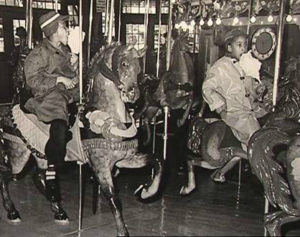Glen Echo started with two brothers, Edward and Edwin Baltzley. Edwin had invented a new and improved egg beater, so the two of them decided to use the proceeds to build their own real estate and educational center. They purchased 516 acres in 1888 and named the land Glen Echo on the Potomac. They also established the Glen Echo Railroad, a streetcar line that opened in 1891.
Glen Echo Park was first used as a site for the National Chautauqua Assembly, an adult education program that also promoted social reform. The topics were usually religious, inspirational, or arts-related. United States President Theodore Roosevelt said of the group, “It is a source of positive strength and refreshment of mind and body to come to meet a typical American gathering like this—a gathering that is typically American in that it is typical of America at its best.” While the gathering was only held there once, the park continued to operate.
In 1911, the park began being used as a “trolley park,” meaning a picnic or recreation area at the end of streetcar lines. New attractions were added each year during this period, including a penny arcade, skeeball alleys, and shooting galleries, as well as a Ferris wheel, a Tunnel of Love, bumper cars, and a wooden roller coaster. None of this is still operational, but several locations can be rented out as a venue for parties or events. The only original ride that remains is the Dentzel carousel. However, even that was one of the first things to be sold off, but luckily, the town was able to buy it back via the efforts of Nancy Long, a Glen Echo Town councilwoman.
The park’s popularity peaked during World War II, but wartime shortages of gas and ammunition (for the shooting gallery) forced the park to close down several rides. Attendance began to wane. Compared to 1944’s 15,000 opening-day attendees in 1950, the crowd had dwindled to 3,000. Many of the employees of the park left to join the war.
This idyllic park wasn’t open to everyone. In the 1960s, the park was still segregated, only allowing white customers in. African American students from Howard University protested and were eventually arrested as they tried to ride the carousel. In spite of the arrests, more joined in from the Bannockburn community, and after a summer of protests, the park opened its 1961 season desegregated.
In 1968, the park closed after years of ups and downs. Originally, the plan was to build homes on the land, but the Department of the Interior and the National Capitol Park and Planning Commission asked the General Services Administration (GSA) to purchase Glen Echo Park and protect the surrounding land. The title was transferred in 1970 to the National Park Service, and they manage the park to this day.
Nowadays, several old attractions have been restored (like the Dentzel carousel), and community programs are held there regularly. Just this month the historic Glen Echo carousel got back five missing animal figures. While only the carousel and the buildings of old attractions still exist, the National Park Service offers guided tours where they teach about the history of the park. Glen Echo is home to many historic landmarks, such as the Clara Barton house, and offers lots of sites to visit. With the acknowledged historical context and continuous start of new classes, Glen Echo can keep one foot in the future and one foot in the past.
Content for this blog was compiled with the help of our Waxter Intern Miel Hunt. Miel Hunt is a recent graduate of the Ithaca College Park School of Communications. Raised in Texas, France, and Maryland, her multicultural upbringing opened her eyes to new perspectives and ignited her passion for history and storytelling. She is thrilled with the opportunity to combine those interests with Preservation Maryland. Having lived 5 years in France, she speaks French and is a bit of a Francophile particularly concerning French history. However, after over a decade in Maryland, she is proud to call it her home.

